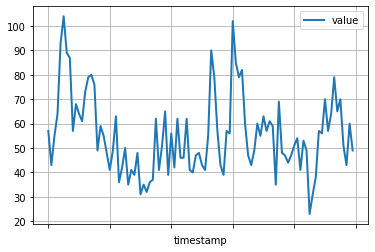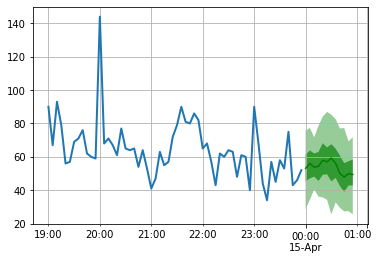GluonTS is a Python toolkit for probabilistic time series modeling, built around MXNet.
Project description
GluonTS - Probabilistic Time Series Modeling in Python
GluonTS is a Python package for probabilistic time series modeling, focusing on deep learning based models.
Features
- State-of-the-art models implemented with MXNet and PyTorch (see list)
- Easy AWS integration via Amazon SageMaker (see here)
- Utilities for loading and iterating over time series datasets
- Utilities to evaluate models performance and compare their accuracy
- Building blocks to define custom models and quickly experiment
Installation
GluonTS requires Python 3.6 or newer, and the easiest way to install it is via pip:
pip install gluonts[mxnet,pro] # support for mxnet models, faster datasets
pip install gluonts[torch,pro] # support for torch models, faster datasets
You can enable or disable extra dependencies as you prefer, depending on what GluonTS features you are interested in enabling.
Models:
mxnet- MXNet-based modelstorch- PyTorch-based modelsR- R-based modelsProphet- Prophet-based models
Datasets:
arrow- Arrow and Parquet dataset supportpro- bundlesarrowplusorjsonfor faster datasets
Misc:
shellfor integration with SageMaker
Documentation
Available models
| Name | Local/global | Data layout | Architecture/method | Implementation | References |
|---|---|---|---|---|---|
| DeepAR | Global | Univariate | RNN | MXNet, PyTorch | paper |
| DeepState | Global | Univariate | RNN, state-space model | MXNet | paper |
| DeepFactor | Global | Univariate | RNN, state-space model, Gaussian process | MXNet | paper |
| Deep Renewal Processes | Global | Univariate | RNN | MXNet | paper |
| GPForecaster | Global | Univariate | MLP, Gaussian process | MXNet | - |
| MQ-CNN | Global | Univariate | CNN encoder, MLP decoder | MXNet | paper |
| MQ-RNN | Global | Univariate | RNN encoder, MLP encoder | MXNet | paper |
| N-BEATS | Global | Univariate | MLP, residual links | MXNet | paper |
| Rotbaum | Global | Univariate | XGBoost, Quantile Regression Forests, LightGBM, Level Set Forecaster | Numpy | paper |
| Causal Convolutional Transformer | Global | Univariate | Causal convolution, self attention | MXNet | paper |
| Temporal Fusion Transformer | Global | Univariate | LSTM, self attention | MXNet | paper |
| Transformer | Global | Univariate | MLP, multi-head attention | MXNet | paper |
| WaveNet | Global | Univariate | Dilated convolution | MXNet | paper |
| SimpleFeedForward | Global | Univariate | MLP | MXNet, PyTorch | - |
| DeepVAR | Global | Multivariate | RNN | MXNet | paper |
| GPVAR | Global | Multivariate | RNN, Gaussian process | MXNet | paper |
| LSTNet | Global | Multivariate | LSTM | MXNet | paper |
| DeepTPP | Global | Multivariate events | RNN, temporal point process | MXNet | paper |
| RForecast | Local | Univariate | ARIMA, ETS, Croston, TBATS | Wrapped R package | paper |
| Prophet | Local | Univariate | - | Wrapped Python package | paper |
| NaiveSeasonal | Local | Univariate | - | Numpy | book section |
| Naive2 | Local | Univariate | - | Numpy | book section |
| NPTS | Local | Univariate | - | Numpy | - |
Running on Amazon SageMaker
Training and deploying GluonTS models on Amazon SageMaker is easily done by using the gluonts.shell package, see its README for more information.
Dockerfiles compatible with Amazon SageMaker can be found in the examples/dockerfiles folder.
Quick example
This simple example illustrates how to train a model from GluonTS on some data, and then use it to make predictions. For more extensive example, please refer to the tutorial section of the documentation
As a first step, we need to collect some data: in this example we will use the volume of tweets mentioning the AMZN ticker symbol.
import pandas as pd
url = "https://raw.githubusercontent.com/numenta/NAB/master/data/realTweets/Twitter_volume_AMZN.csv"
df = pd.read_csv(
url,
index_col=0,
parse_dates=True,
header=0,
names=["target"],
)
The first 100 data points look like follows:
import matplotlib.pyplot as plt
df[:100].plot(linewidth=2)
plt.grid(which='both')
plt.show()
We can now prepare a training dataset for our model to train on.
Datasets in GluonTS are essentially iterable collections of
dictionaries: each dictionary represents a time series
with possibly associated features. For this example, we only have one
entry, specified by the "start" field which is the timestamp of the
first datapoint, and the "target" field containing time series data.
For training, we will use data up to midnight on April 5th, 2015.
from gluonts.dataset.pandas import PandasDataset
training_data = PandasDataset(df[:"2015-04-05 00:00:00"])
A forecasting model in GluonTS is a predictor object. One way of obtaining
predictors is by training a correspondent estimator. Instantiating an
estimator requires specifying the frequency of the time series that it will
handle, as well as the number of time steps to predict. In our example
we're using 5 minutes data, so freq="5min",
and we will train a model to predict the next hour, so prediction_length=12.
We also specify some minimal training options.
from gluonts.model.deepar import DeepAREstimator
from gluonts.mx.trainer import Trainer
estimator = DeepAREstimator(freq="5min", prediction_length=12, trainer=Trainer(epochs=10))
predictor = estimator.train(training_data=training_data)
During training, useful information about the progress will be displayed.
To get a full overview of the available options, please refer to the
documentation of DeepAREstimator (or other estimators) and Trainer.
We're now ready to make predictions: we will forecast the hour following the midnight on April 15th, 2015.
test_data = PandasDataset(df[:"2015-04-15 00:00:00"])
from gluonts.dataset.util import to_pandas
for test_entry, forecast in zip(test_data, predictor.predict(test_data)):
to_pandas(test_entry)[-60:].plot(linewidth=2)
forecast.plot(color='g', prediction_intervals=[50.0, 90.0])
plt.grid(which='both')
Note that the forecast is displayed in terms of a probability distribution: the shaded areas represent the 50% and 90% prediction intervals, respectively, centered around the median (dark green line).
Contributing
If you wish to contribute to the project, please refer to our contribution guidelines.
Citing
If you use GluonTS in a scientific publication, we encourage you to add the following references to the related papers, in addition to any model-specific references that are relevant for your work:
@article{gluonts_jmlr,
author = {Alexander Alexandrov and Konstantinos Benidis and Michael Bohlke-Schneider
and Valentin Flunkert and Jan Gasthaus and Tim Januschowski and Danielle C. Maddix
and Syama Rangapuram and David Salinas and Jasper Schulz and Lorenzo Stella and
Ali Caner Türkmen and Yuyang Wang},
title = {{GluonTS: Probabilistic and Neural Time Series Modeling in Python}},
journal = {Journal of Machine Learning Research},
year = {2020},
volume = {21},
number = {116},
pages = {1-6},
url = {http://jmlr.org/papers/v21/19-820.html}
}
@article{gluonts_arxiv,
author = {Alexandrov, A. and Benidis, K. and Bohlke-Schneider, M. and
Flunkert, V. and Gasthaus, J. and Januschowski, T. and Maddix, D. C.
and Rangapuram, S. and Salinas, D. and Schulz, J. and Stella, L. and
Türkmen, A. C. and Wang, Y.},
title = {{GluonTS: Probabilistic Time Series Modeling in Python}},
journal = {arXiv preprint arXiv:1906.05264},
year = {2019}
}
Other resources
- Collected Papers from the group behind GluonTS: a bibliography.
- Tutorial at IJCAI 2021 (with videos) with YouTube link.
- Tutorial at WWW 2020 (with videos)
- Tutorial at SIGMOD 2019
- Tutorial at KDD 2019
- Tutorial at VLDB 2018
- Neural Time Series with GluonTS
- International Symposium of Forecasting: Deep Learning for Forecasting workshop
Project details
Release history Release notifications | RSS feed
Download files
Download the file for your platform. If you're not sure which to choose, learn more about installing packages.
Source Distribution
Built Distribution
Hashes for gluonts-0.10.0rc1-py3-none-any.whl
| Algorithm | Hash digest | |
|---|---|---|
| SHA256 | 7a38644e1483e4973db536b5bd6c4c97c5063d57cbbcffaea9e855101f75e9fd |
|
| MD5 | 574db9f90da65bf099aa70657211204f |
|
| BLAKE2b-256 | 4cba4bad6b4f09a21d15b2df6b5a481c2406090ce8d10767cb3bc315091d87f5 |




















